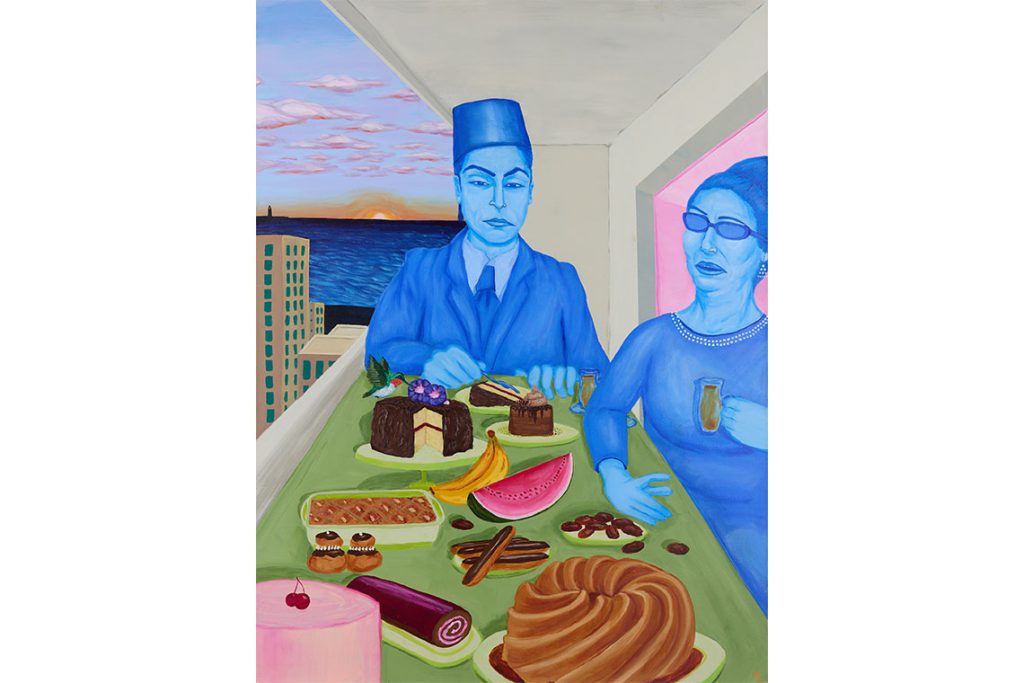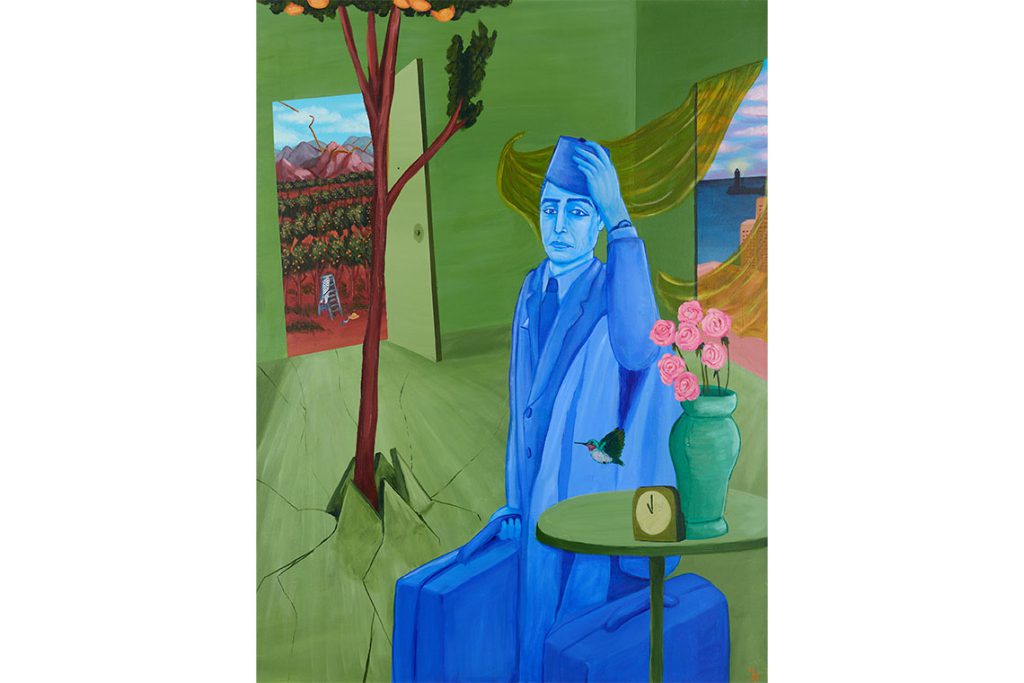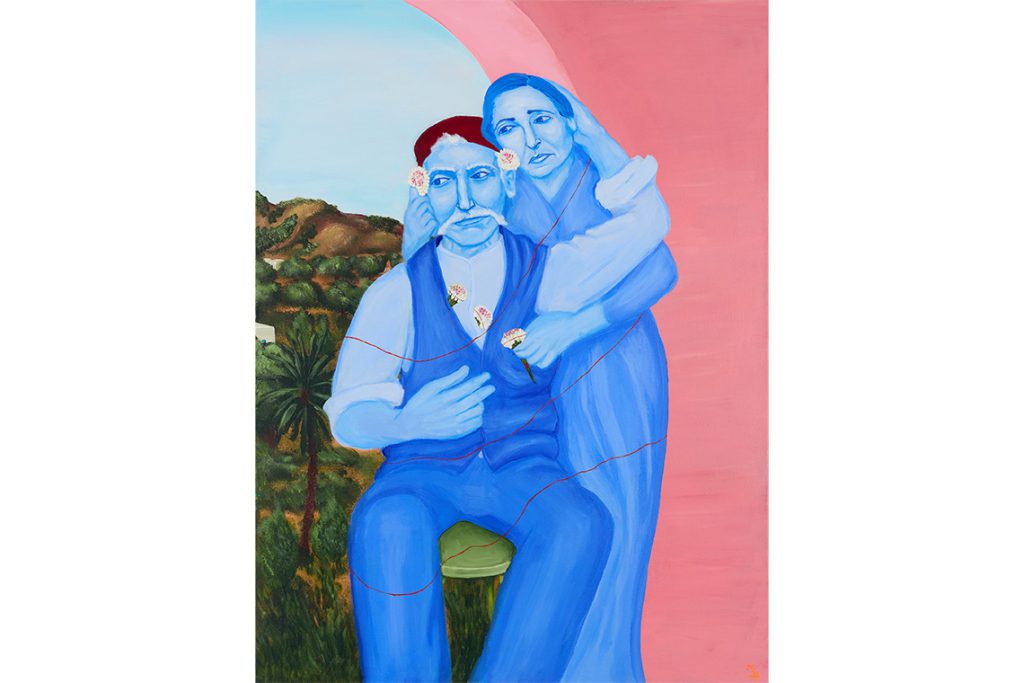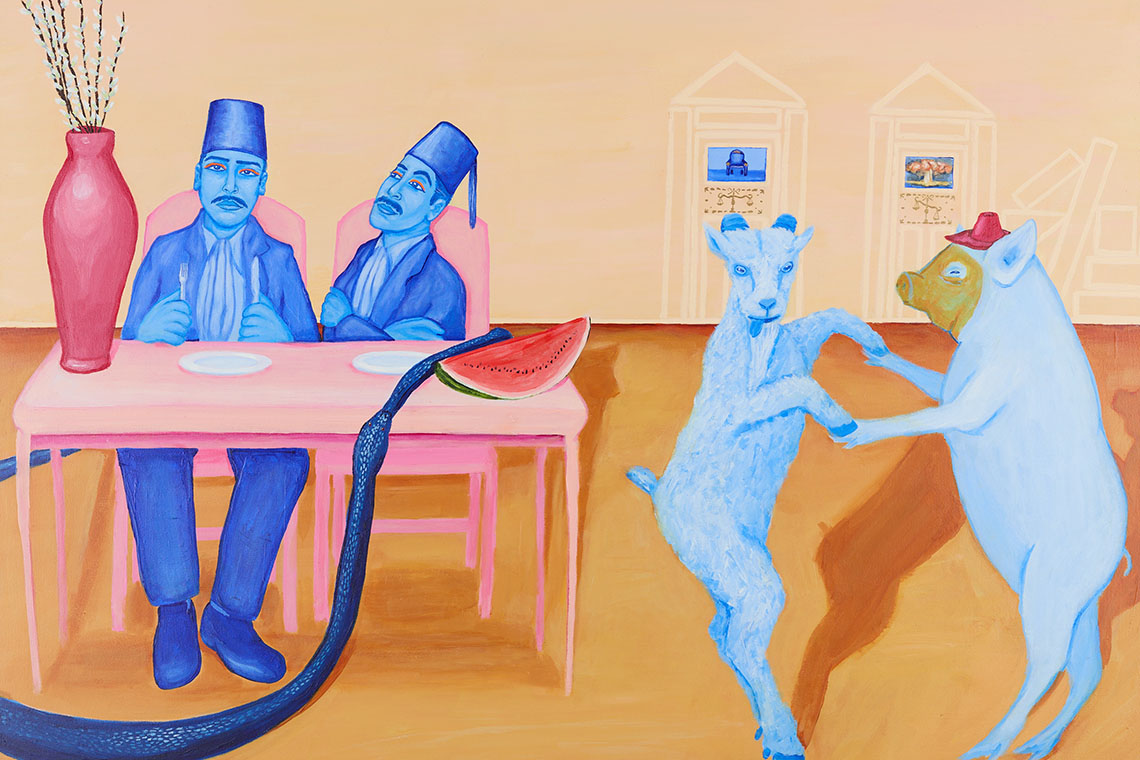At London’s Larkin Durey, Massoud Hayoun – former Al Jazeera journalist and author of the award-winning When We Were Arabs: A Jewish Family’s Forgotten History – presents new work as delicious, enraged and subversive as ever.
You want to take a bite into Massoud Hayoun’s paintings. There are dining tables laden with soft cakes, fresh fruit, dates, pastries, tea and coffee, and with hookah pipes snaking between them. A cast of figures is washed in shades of blue, referencing accents in Tunisian architecture and the dizzying hue of the world’s first artificial pigment, dating back to ancient Egypt. Each figure’s expression is layered and distinct, eyebrows darkly arched with flamboyance, melancholy or humour. Men in fez smoke and eat with manicured moustaches and eyes rimmed in hot pink liner. One has tea with Umm Kulthum by the Nile; another swings through windswept branches in his underwear, holding onto a woman saviour (who resembles Beyonce to me) for his dear life. In all, the colours are as deep as clots of syrup, like scenes in 1950s Technicolor films from Hollywood or Egypt.

Hayoun was born in Los Angeles and raised by his Jewish grandparents, who migrated there via Paris; his grandfather left Egypt and was stateless for some time, while his grandmother was of Moroccan and Tunisian heritage. His mother was born without citizenship. This geographical constellation and its anxieties form the engine of Hayoun’s practice. In his second solo outing at Larkin Durey in London, titled Stateless, Hayoun’s examination of the places constituting his history, resisting preimposed ideas of what it means to be Arab and Jewish, gets denser with other transnational resistances and solidarities. It goes even further, disputing the stability of citizenship and of having a ‘state’.
In the show’s titular painting, Stateless • Por no llevar papel (2024) – the Spanish meaning ‘For not carrying paper’ – Hayoun depicts his grandfather as a younger man, just as he is about to leave his home in Egypt. Eyes and mouth weighted, both his figure and suitcases are vivid blue –– a ghost-like apparition, he is rendered both invisible and legible by his migration. The floor beneath him cracks as an apricot tree (referencing a childhood nickname for the artist) erupts out of it. Nature and land, even and especially through memory, triumphantly eschew our efforts at control and regulation. I was struck by the painting’s overlapping temporalities, an idea emphasised by a clock on the table and the wristwatch peeking out from a sleeve. It reminded me of Samira Azzam’s short story Out of Time, which shows occupation transforming how time is felt in everyday Palestine. The narrative within Hayoun’s paintings often feel similarly contained and complex as the short story form, perhaps because they illuminate oral stories passed to him by his elders.

Resistance against the unfolding genocide and occupation of Palestine is visible in nearly every work. You can spot a keffiyeh in the background of Stateless. In Alexandria, Momentarily (2024), a tiny bird is painted in the colours of the Palestinian flag. A peace sign emerges from the white rind of a cut pomegranate. Watermelons are frequently prominent. These are unmissable motifs that unite the varying narratives of Hayoun’s paintings under what may be this era’s most significant anti-colonial movement – the fight to free Palestine.
Some works elaborate Hayoun’s reporting experiences in the USA and Mexico – before painting, Hayoun was a journalist, working for Al Jazeera. What he witnessed finds a valve of expression on the canvas. Anatomy of a Raid (2025) portrays an “early morning immigrant deportation raid at the start of the last Trump administration”, in which Hayoun transplants his grandfather (appearing exactly as in Stateless) and his grandmother at a Mexican American family’s breakfast table, the shadows of ICE agents looming in the window. In Sick of Foul, I’ll Take the Goat (2024), the two recent presidents of arguably the world’s most influential nation are a pig and a goat in lockstep.

Barely a week after the opening of Stateless in London, Hayoun was arrested and temporarily detained for participating in one of many peaceful anti-ICE protests in LA – a harrowing experience that he covered in real-time on Instagram. Even at this exhibition’s opening, one heard him talking animatedly about the urgent need for political change over perhaps the iconography in his paintings – yet the two work in tandem. His numerous depictions of food and dining, for instance, hark back to the time when he worked for Anthony Bourdain on Parts Unknown, a show that revolutionised how ordinary people see food as a sociopolitical object as well as peacemaker.
Within scenes coloured like milkshakes, Hayoun’s symbols and references serve as effective lures towards his pointed political critiques. There are only eight paintings in this show, yet their visual cohesion and sense of voice are so strong that it feels more expansive. Aesthetics aside, there are also elements of dark comedy, absurdity and play. These are vivacious and irresistible artworks, poised to flirt with your eye. I find in them a contemporary Romanticism, a willingness to surrender to every shade of emotion, with an unshakeable sense of love for other people, lands and earth (nowhere more tenderly apparent than in the lovers’ portrait of his great-great grandparents, Uncynical Tunisian Love Painting (2024)). The subversiveness, the drama, the snarling, luscious bite, queer what we think of as fixed, whether identities, boundaries or states. It’s hard to imagine Hayoun’s blaze into the art market slowing anytime soon – and thank goodness for that.



